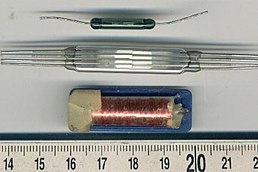Reed relay

A reed relay
Compared with armature-based relays, reed relays can switch much faster, as the moving parts are small and lightweight, although
Memory device
A few million reed relays were used from the 1930s to the 1960s for memory functions in
Such an electrically latching reed relay requires continuous power to maintain state, unlike magnetically
Crosspoint switch
In the Bell System
Each input of the array had, besides the two talk wires, a P lead for controlling the crosspoints on that level. Two coils on each crosspoint were wired in series with all the others on that level, to the P lead. Each output of the array also had a P lead with two coils on each crosspoint of that output level. The two windings controlled by the same level were unequal, and were wound around opposite ends of the reed, in opposing polarity. When a pulse passed through the crosspoints of a level, the two ends of each reed were magnetized north to north or south to south, thus repelled each other and opened the crosspoint in all except the selected crosspoint.
The selected crosspoint had current passing through both its input P lead and its output P lead, thus through all four windings. On each end of the ferreed, the windings provided by the two different P leads were opposed to each other, and the greater one predominated when both were energized. This being the input P lead at one end of the ferreed, and the output P lead at the other end, the two ends of that particular ferreed were magnetized north to south, hence attracted each other and closed the contact. Current was applied by the pulser only to set up the connection. The P leads remained dry and the crosspoint remained closed until such time as another connection was made involving one of the levels.[3]
Because the individual crosspoints were more expensive than those of
In the later 1AESS, the reeds were of remanent magnetic material. This "Remreed" design allowed further reduction in size and power consumption. A "grid" of 1024 2-wire crosspoints, arranged as two stages of eight 8×8 switches, was permanently packaged in a box. Despite the sealed contacts, plating with silver rather than with precious metals resulted in reed arrays being less reliable than crossbar switches. When one crosspoint failed, the grid box was quickly replaced as a unit, and either repaired at a local workbench or shipped to a repair shop.
Stromberg-Carlson made the similar ESC system, whose reeds were called crossreed.
Reed relays were extensively used in the British TXE family of telephone exchanges.
Other uses
Reed arrays passed out of use in the mid-1990s, being unnecessary in digital telephone systems such as
See also
- Mercury-wetted reed relay
- PRX (telephony)
- Reed receiver
- TXE (Telephone eXchange Electronic)
- Vibrator (electronic)
Notes
References
- ^ Hewes, John (2013). "Relays". Electronics Club. Archived from the original on 2020-06-21. Retrieved 2020-06-21.
- ^ "How do reed relays compare with other switching technologies?". Clacton, Essex, UK: Pickering Electronics Ltd. 2018-05-02 [2016-04-07]. Archived from the original on 2020-06-21. Retrieved 2017-10-23.
- ISBN 978-1-46156291-7.
- ^ "Reed relays live long and prosper". ECN Asia.
- Standard Elektrik Lorenz: 6–8.
- LCCN 62-14511.
- International Telephone and Telegraph Corporation (ITT): 171, 244–259 [245–246, 251, 254–257]. Archived(PDF) from the original on 2020-06-21. Retrieved 2020-06-21.
- ^ Oden, Hoeckley (October 1964). "Actual Problems Of Telephone Switching - Quasi-Electronic Solutions For Switching Systems" (PDF). The Telecommunication Journal of Australia. 14 (5/6). Telecommunication Society of Austria: 342–355 [350, 355]. Retrieved 2020-06-21.
The dry reed switch manufactured by SEL is sold under the registered name "Herkon" (hermetically sealed contact).
- LCCN 67-21079. Title No. 1036.
Further reading
- Hovgaard, Ole M.; Perreault, George E. (1955-03-02). "Development of Reed Switches and Relays". ISSN 0005-8580.
- Feiner, Alexander; Lovell, Clarence A.; Lowry, Terrell N.; Ridinger, Philip G. (January 1960) [1959-09-14]. "The Ferreed - A New Switching Device" (PDF). ISSN 0005-8580. Archived from the original(PDF) on 2012-04-12. (30 pages)
- Angner, Ronald Joseph; Feiner, Alexander; Olsen, Merle Victor (1974-02-19) [1973-07-12]. "Remanent Reed Relay". New Jersey, USA. US Patent US3793601A 05/378581. (NB. On Remreed design.)
